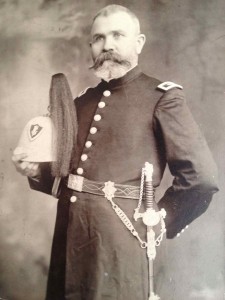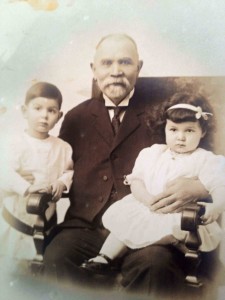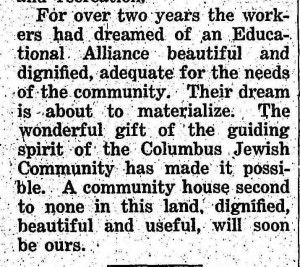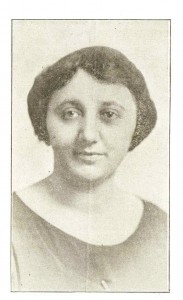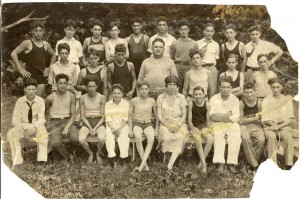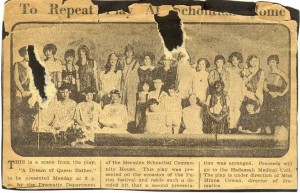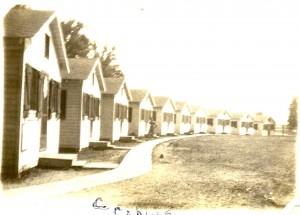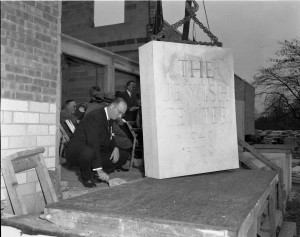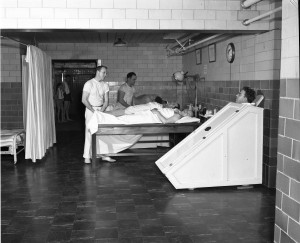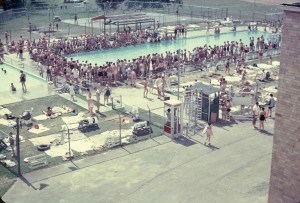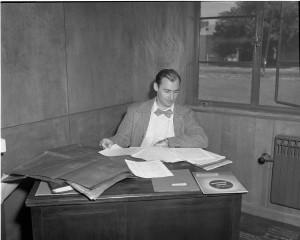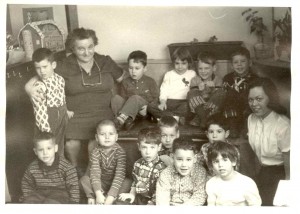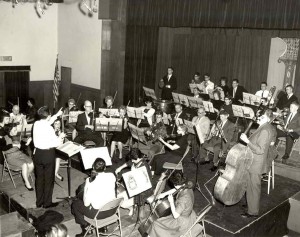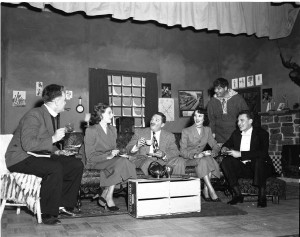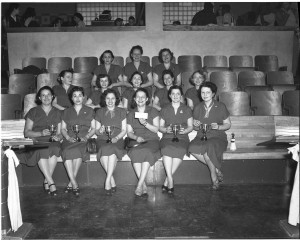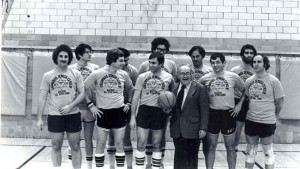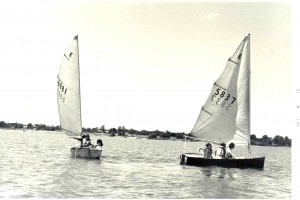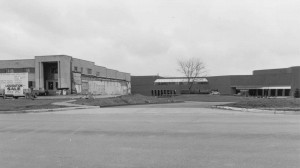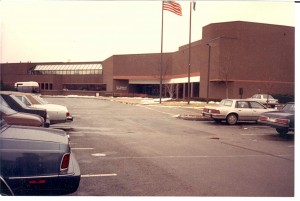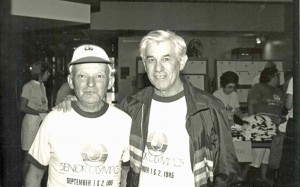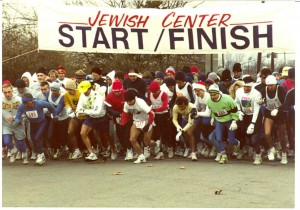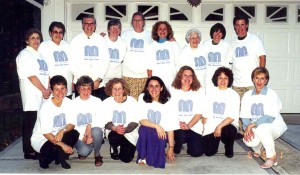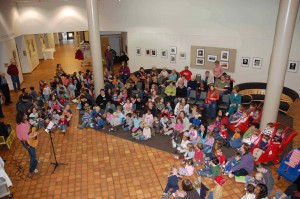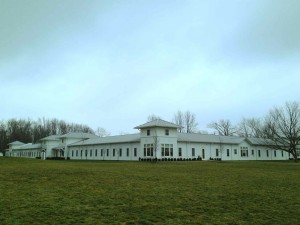The Jewish Community Center of Columbus (JCC)
1913-2013
Compiled by Bette (Abel) Roth Young
I –
1913-1918 – Jewish Educational Alliance – Simple Beginnings
In 1887, Joseph Schonthal, a young Hungarian Jewish peddler, set aside his horse and cart and put down roots in Columbus, Ohio. He became the most prominent Jewish immigrant in Columbus at that time, beloved by men, women and children as “Pop” Schonthal. Joseph Schonthal was born in 1854, to a prosperous Jewish family. He served as an officer in the Emperor Franz Joseph of Austria-Hungary’s army and then as superintendent of a royal estate in the same country.
Married with three children, he came to the United States as had so many others, to provide an escape from the Empire’s onerous draft. Having peddled his wares throughout Ohio, he decided to settle in Columbus where he founded the Joseph Schonthal Company which manufactured iron. Having prospered in Columbus, he established the West Virginia Rail Company in 1907.
Then, tragically, in 1910, Joseph Schonthal’s beloved wife, Hermine, died. Schonthal retired from business and devoted the rest of his life to helping others. By that time, Schonthal had four children: two sons, Dez and Bela; and two daughters, Marguerite and Irene.
Schonthal became a nationally respected philanthropist, without doubt, the most prominent Jewish leader in Columbus. He served as president of the Reform synagogue, Temple Israel, as well as president of the Federated Jewish Charities from its inception. These two institutions were the most prestigious in Columbus. It is indicative of Schonthal’s unique leadership abilities that he, a first generation immigrant, should be president of both.
In addition to membership on the board of Big Sisters, he was on the boards of the Columbus Cancer Society, Florence Crittenden Home, Winding Hollow Country Club, B’nai B’rith, Knights of Pythias, Columbus Lodge of Elks, Masons, Odd Fellows and the Columbus Athletic Club. But the role that Schonthal loved best was that as “Daddy” to the hundreds of boys and girls who frequented the Hermine Schonthal Home, established in 1918 in memory of his precious wife. And a “home” it was. It immediately became the center of Jewish life on the South side of Columbus. In 1919, he established the adjoining Jewish Infant Orphans’ Home of Ohio for the care of small children.
The Schonthal Center, as the Hermine Schonthal Home came to be known, was not the first “Jewish community center” in Columbus. The Jewish Educational Alliance, established in 1913, was the first Jewish center and the prototype for future Jewish centers in Columbus. Joseph Schonthal was instrumental in establishing and supporting this institution. It is said to have been housed in two different locations on Washington Street, but two early residents, Sara Schwartz and Sylvia Schecter remember it as on the corner of Stauring Street and Donaldson Avenue.
Whatever its first location, it was a remarkable institution. Its superintendent, H. Joseph Hyman, reported on the Alliance in an article in the Columbus Jewish Chronicle, published in 1918. He writes that “[s]elf expression is the greatest need of any people. It means development, it makes for progress. Life in a Jewish neighborhood would indeed be drab without it. Deprive the boy of the club and his playing, the girl of her sewing or cooking class, the woman of her Mothers’ Club and the best asset for Community spirit has been eliminated. The Jewish Educational Alliance offers the boy, the girl, the man and the woman of the neighborhood an opportunity for self-expression for self-improvement and for Community betterment.”
The Educational Alliance would not be a Settlement House, however. It must be a Jewish center of recreation, “for common meeting, for communal cooperative action.” Most important, the Alliance would not be for any one class of Jews but for the entire community. It would be the only institution that could do this. As Hyman wrote, “shades of faith and differences of wealth divide people.” The Alliance would bring different classes of people together for common purpose. It would be,” said Hyman, “a democracy in miniature.”
The first Jewish community center in Columbus, housed in the most unpretentious of circumstances offered an amazing array of opportunities for “self expression” for men, women and children of all ages. It is worth going into detail because this framework would be the basis for the second Jewish community center, opened in 1918, the Hermine Schonthal Home which remained in operation for some thirty years.
The Alliance’s underlying goal was to “relate the members of the organizations meeting within its walls to each other, to their families, to the community and finally to humanity . . .” endeavoring to “develop a responsibility to family, faith and nation.” Lofty goals, indeed.
The boys clubs stressed athletics and “our boys, given half a chance, become good athletes.” In fact, the Alliance basketball team held second place in the City Church league, even though it had no gymnasium. Debating was stressed: it gave the boys not only knowledge of current events, but confidence in themselves and inculcated in them a spirit of fairness. The girls “improved themselves” with knitting, sewing and reading.
The Alliance had a religious school which endeavored to “acquaint the child with the great heritage of Israel.” The Jewish holidays were observed. The purpose of this exposure was to bridge the gap between the American child’s experience and interest and that of his or her immigrant Jewish parents.
The Mother’s Welfare and Social Club had a definite purpose, stated in its constitution:
- Improvement of the members in education, in the training of children in matters of health and home economics;
- To foster a spirit of friendship and neighborliness.
- To bring about a better co-operation of the members of the FultonStreetSchool and the Jewish Educational Alliance;
- To study the ways and means of improving the living conditions in the neighborhood.
Amazingly, there were 35 different activities in the center, which during any evening of the week was a “veritable beehive of action.” The center had a library of both Yiddish and English books. Monthly concerts brought the “best in music to the people;” a children’s chorus was rehearsing a cantata and the boys’ organization was rehearsing the second annual minstrel show.
Two loan societies extended “timely aid to many, saving them the embarrassment of having to appeal for charitable relief.” If all of this were not enough, French lessons were offered and many organizations in the neighborhood were offered rooms for gatherings and recitation. This remarkable little center was the single most important institution in melding together the many different dialects, alliances and practices of an east European immigrant population, the many countries making up the Czar’s Russia.
For over two years, the Alliance had dreamed of their organization housed in “beautiful and dignified” quarters, adequate for the needs of the community. Finally, their dreams would be realized through the “wonderful gift of the guiding spirit of the Columbus Jewish community: who had made it all possible.” A community house, “second to none in the land, dignified, beautiful and useful” would soon be theirs. That “guiding spirit” was “Pops” Schonthal. His new Jewish Center would be the crowning jewel of the Jewish community.
II –
1918-1948 – The Hermine Schonthal Children’s Home – Schonthal Center
When Joseph Schonthal’s wife died, he could have become a bitter recluse. Instead, he turned to the members of the community that had nurtured him and fell in love with them all. Schonthal’s limitless capacity for love is what defined him as a leader. In his every endeavor, his love for his community informed the action he took. In 1918, Schonthal purchased the magnificent Hoster Mansion, home of the Hoster Brewing family dynasty. With eighteen magnificent rooms and an enormous garage, it would seem to be an unlikely setting for an immigrant population’s community center. But Pop Schonthal had a vision and he had the wherewithal to turn that vision into reality.
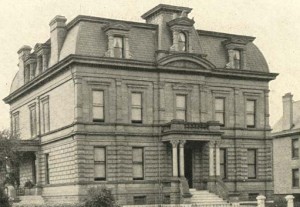
The Hermine Schonthal Center, forerunner to the Jewish Center, was located at 555 E. Rich Street, Columbus.
Rather than the institutional-like settings of most settlement houses, orphanages or community centers at that time, Pop wanted an elegant setting for his boys and girls, men and women who would be spending so many hours there. An article was published in the Columbus Jewish Chronicle in 1919, titled “The Schonthal Home.” The author bragged that no other city in the country could “boast of an institution as wonderful in appearance and as useful in its functions as the Hermine Schonthal Home of Columbus.” The author advised that those who would think this statement an exaggeration would do well to visit the “luxurious mansion on East Rich Street,” to witness its “facilities and comforts.” They would leave thoroughly “convinced of the truth of what was said above.”
The Schonthal Home was a “home” in every sense of the word. It is, the author wrote, “the nursery, the music room, the parlor, the kitchen, the backyard, and the playground of the Jewish Youth of Columbus.” This article was written one year after the home was opened.
He remarked that because the home was the gift of and maintained by one man, it had none of the characteristics of “ordinary community institutions.” It was, he wrote, “more individual, more human.” It bore the personality of the individual who “endowed the community of Columbus with a Home.”
That individual was, of course, Joseph Schonthal who seemed to have found the “sense and purpose of existence in charity and helpful service to his fellow beings. Hearts like his are the hope and treasure,” it wrote, “of mankind.”
In 1931, another article described in more detail the Home’s parquet floors, its stained glass windows and bronze fireplaces. The drawing room had been turned into a pre-school classroom. The “large tiled bathroom” became a free dental clinic, and the huge carriage house had become a gymnasium complete with showers and game rooms. The conservatory had been turned into cubicled offices and the bedrooms were turned into clubrooms.
We don’t need to imagine what those young children who spent so much of their time in this elegant environment thought of this first substantial Jewish community center in Columbus. The Oral History Project of the Columbus Jewish Historical Society has transcribed a number of tapes of members of the community who remember those times.
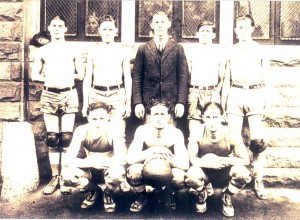
YMHA Basketball team at Schonthal
Front row center: Mose Solomon.
Rear row: Joe Bonowitz, coach; Lou Soppel, far right.
Here are some descriptions of the SchonthalCenter, as it quickly became known, by those who were there. Community leader Sylvia Schecter remembered that next to the Center in back of it a huge stable became the gymnasium where sports were held. She recalled that inside the Center the girls were given the opportunity to learn how to sew in a sewing room which was on the second floor next to the library.
She remembered learning to cook in a huge room “set up with cupboards three times around the room and on top of the cupboards were these Bunson burner type ovens, hot plates. Down below, she recounted, they were “experts” in making cream sauces. They were so good that years later she continued to serve them to her friends.
Mrs. Schecter remembered how she used to sit on “Daddy” Schonthal’s knee. Art Levy remembered Pop Schonthal driving to the Center on Sundays in his electric car “powered by a number of batteries in the trunk.” He would come in and sit in a chair by a beautiful grandfather’s clock. All the children would climb up on his knee. “There must have been 20 of them. They’d crawl all over him and he just loved it.”
He described the coach house or garage which was just big enough for a basketball court with “about a foot outside of the foul line.” He said that the walls were padded with wrestling matting. We thought, he said, “it was the world’s greatest.”
Honey Abramson remembers that on the third floor of the Center was an auditorium with a stage. All sorts of groups performed there for the entire community.
Irvin Roth described Schonthal as a “beautiful man. I’ll never forget him as long as I live,” he said. “You ask anyone that came over in the era of the nineteen-twenties, the Schonthal Home was the hangout for Jewish youngsters.”
Soon after the Center opened, Rose Sugarman was brought up from Atlanta to help run the place, first, with Joseph Hyman and then with Maurice Taylor. These two very talented Jewish professional communal workers went on to serve with the Joint Distribution Committee and in Federated philanthropy for a number of years. Soon after Sugarman came to Columbus, however, it was apparent that she could run the place on her own, Rose Sugarman was a remarkable woman. She ran both the SchonthalCenter and the Columbus Jewish Federation for many years.
Sara Schwartz, an outstanding lay leader in the community, remembered Rose as having never lost her Southern accent. Her accent may have softened her image but she was tough. Sara said that all of the mothers were “terrified of her, so frightened of her because they had to come to her. She was THE family service. There was no family service,” she reminded us,” and if you needed money to send your child to business school, you had to go to Miss Sugarman.”
From the beginning, this remarkable institution would be a place for boys to learn the manual arts and printing and for the girls to learn cooking and sewing. It would also be a center for high culture as well. The finest musicians and artists in Columbus could be found teaching or performing there. From the beginning, not only were children involved, but their mothers played an active role as well.
On January 10, 1919, the opening program of the Mother’s Club was a “huge success.” It was written up in the Columbus Jewish Chronicle and is a rare primary resource for life at the Home. It is instructive to go into this report in some detail because it is as if we are able to sit on the shoulders of those who were there to get a precious birds-eye view of the importance of the event.
Some two hundred women greeted the three “splendid artists” on the program who were “prominent in the world of music and letters.” Miss Eva Frosh was chair of the music and entertainment committee at the Home. Not only that, she was president of the prestigious MacDowell Club of Columbus and an active member of the Women’s Music Club. She opened the meeting with a “few appropriate words” of welcome.
She addressed the mothers of this “glorious home’ which had been given by our “revered and good friend Mr. Schonthal, a man known as the greatest and most distinguished philanthropist in our city,” in memory of his beloved wife Hermine Schonthal.” “Your coming”, she told the participants, “proves the success of our efforts and that you are not only interested in our meetings, but that our programs, which we plan and so dearly love to plan, are enjoyed.”
She introduced Mrs. McMahon, one of the three artists on the program who told a story of a little Romanian “Jew boy ” [sic] brought here to grow up in the slums of the Lower East Side. She followed him as he grew up, playing his “little fiddle” in his father’s barber shop, with a “God-given talent that early attracted the attention of professional musicians in the neighborhood.”
She followed him as he went to the “Great Musical Settlement School,” and then a few years after saw him sail for Europe to study with the great violinists there. When he came back to the United States he gave his “opening concert” in New York and the” poor little Jew boy of yesterday’s slums won the most signal triumph and the most tumultuous applause from a house crowded with the wealth and culture of the Metropolis.” It was her wish to enable other such young talent in the immigrant streets of every city.
Why is this little episode important? At the Hermine Schonthal Home in Columbus, Ohio, the bar of achievement was as high as each child could dream to go. This wonderful first community center, truly the center of the Jewish immigrant population, had high aspirations for the children it served. Many went on to great accomplishment.
Several days after this piece appeared, another article titled Schonthal Home Activities was published on the front page of the paper describing just what was happening there. Pop Schonthal was in full control. “Guided by the magnificent intent and spirit of Mr. Joseph Schonthal, the man who has made the home such a splendid reality for Columbus,” the article reported, every effort was bending to carry out the “charitable ideas of the giver and to build up an institution that is verily the pride and inspiration of Columbus.” This home would not be your standard “institution” for the community’s poor.
For the kindergarten children, a doll house was provided, where they could “play and learn how to be kind and helpful and to keep house.” A filling class was held for the girls in the afternoons and evenings where they were “engaged in making and filling of various things such as pillows, cushions and the like. A class of storytelling for girls of six or seven was conducted every afternoon to stir their “youthful imagination” and to “instill in them the love of the true, the honorable and the beautiful.”
A class in china painting would soon be started. The older girls would, of course, continue in their cooking classes. The billiard room was open and the library of the Home offered Jewish readers a number of “well-selected and representative books on practically every phase of Jewish life.”
But one of the “greatest boons” of the Home to the residents of Columbus was its “contemplated series of concerts to be given by the best musical talents of the city.”
By 1922, the Home offered a free Dental Clinic to be held every Monday, Wednesday and Friday morning at the home. Children must bring a note from their principal stating that they were eligible for this free treatment. The Ohio State Dental Clinic provided services. A prenatal clinic was open every Monday afternoon. Dr. Sam Edelman presided over an Infants Clinic in the Schonthal in 1922. This weekly Thursday afternoon service was free to anyone who presented a note from the District Nurse confirming eligibility.
At the same time, Americanization Classes were held at the Home under the auspices of the Board of Education. The teacher was one who “thoroughly” understood the background of the foreigner, his life and customs.
In 1924, a “Little Theatre of the Schonthal Home” had been organized for several purposes. First, it would provide community entertainment and second, it would provide the development of dramatic interest in the neighborhood. Made up of a group of girls, it would produce all religious plays for their respective holidays in addition to occasional modern plays. In 1924, the group put on a Chanukah play for the Jewish inmates at the Ohio Penitentiary.
The Jewish Literary Club was organized early on. Any young man or woman eighteen years or older was eligible to join. It was far more than just interested in literature. For example, in December, 1924, a meeting was held at which the program consisted of a talk on Religion and Nationalism, a reading was rendered as well as violin selections.
The dramatic section of the club was rehearsing a “Jewish playlet” and the Girls’ Glee Club section was in the process of organization under the direction of the president of the Franklin Conservatory of Music.
In addition, the club was interested in Zionism and its members served as volunteers for Flag Day for the benefit of the National Fund (Jewish National Fund). A concert, play and dance had been given for the benefit of the National Fund by the Club.
As for the boys at Schonthal, they were kept busy as well. The YMHA was one of the earliest organizations to be founded at the Home. Boys between the ages of 13 and 17 were eligible for membership. This group put on a series of Minstrel Shows among other activities. Of course, the boys loved the various opportunities for sports teams and events.
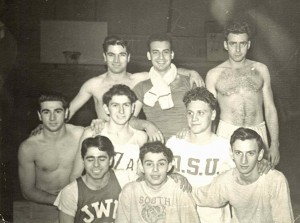
BBYM Wrestling, 1947
Front: Mal Kreske, Jackie Gaiser, Marv Rosen
Middle: Saul Komesar, Murray Greenberg, Bob Bender
Rear: Sam Komesar, Dave Coopersmith, Butch Gordon
Sports at Schonthal Center were central to the experience of children of all ages, mostly, however, in the case of boys. Sports afforded all kinds of opportunities and experiences that these children would never have had, had they been left to their own devices, playing kick ball and baseball in the crowded streets in their neighborhoods. The Schonthal Center became a part of the sports network for men and young boys in the Columbus area.
In 1925, “The Schonthal Courier,” an in house newspaper, edited and written by the children was published. In it, various activities at the Home were described. Art Miller, the manual training instructor and sign-painting teacher, described the telephone stands, serving trays, hall trees, sewing cabinets, miniature pool tables and other items made in the elementary and advanced manual training classes which had been organized two years before. The work-working groups included boys from ages nine to sixteen who met twice weekly in the evening.
The elementary classes made household articles including new milk bottle holders, towel holders and toothbrush holders as well as kites and marble games. Every Thursday night, Miller conducted an “enthusiastic group” in the sign painting class. These signs were then sold to firms downtown. One of the class members painted fifteen signs in one week. The print class was a favorite. It published the Courier under the supervision of the instruction, Mr. John Wildi. Large printing presses were used to “feed thousands of sheets” that made up the eight page Courier.
In the 1925 edition of the Courier, Pop Schonthal announced that “with God’s help, when the Home reopens in the fall, they expected to equip an electrical and radio shop for the boys and girls in the community.”
As early as 1918, the Schonthal Center encouraged community groups to meet there. For example, in December of that year, the “Chronicle” announced that all social agency workers were encouraged to attend the organization meeting of the YMHA. This request was made in an effort of the Schonthal Home to centralize community activities. Many organizations met at the Center during its thirty years of operation. Public meetings were held there as well as youth organizations such as the Boy Scouts of America.
When Schonthal was questioned as to why he had established this home he replied, “I saw the need of taking care of the groups of boys and girls who were playing in the streets wasting their lives in idleness. I wanted to help them develop their characters and become worthwhile members of society.”
III –
Camp Schonthal
“Some men dream dreams, but have not the good fortune of seeing those dreams realized; other men dream dreams, and from these dreams are able to visualize, Such men build under their dreams a foundation based upon sound judgment, altruism, philanthropy and love of fellowmen, will all of which Dad Schonthal is so largely endowed and blessed.”
Ed Schanfarber, another community giant, shared these words with the hundreds of men, women and children who met to celebrate Pop Schonthal’s 73rd birthday. The dream he was referring to was CampSchonthal, envisioned and built by its founder at Magnetic Springs, Ohio. In 1926, Schonthal, at the age of 72, brought together a group of fifteen men and one woman to look at a parcel of land he had purchased just outside of Columbus. It was his dream to create a fresh-air camp for children and women, mothers and career women who were given the chance to spend at least a week during the hot, humid Columbus summer at the beautiful, coolness of the waters of Magnetic Springs.
These men became the officers and board of directors of the camp as well as its financial supporters. All were leaders in the community. They were: Leon J. Goodman, President; Abe Weinfeld, Vice President; Rose Sugarman, Secretary; and Mark Feinknopf, Treasurer. Joseph Schonthal would be Honorary President. Members of the Board of Directors were: Ed Hyman, Allan Gundersheimer, Ed Schanfarber, Max Stearn, Frank Glick, S.M. Levy, Edgar H. Isaac, Arthur Cohen, Leo Yassenoff, Max Reiser and A. J. Kobacker, recognized names in the community.
This summer camp, dedicated on Schonthal’s birthday, had been built, as Schanfarber continued, “for the boys and girls of this community, and the mothers and babies, a practical and economical opportunity for the building and development of character, mind and body.” Schonthal contributed the camp, the main buildings and the swimming pool, leaders in the community contributed the rest. During the first eight weeks of the camp’s existence, 6731 meals had been served to 321 campers from age 2 to 72.
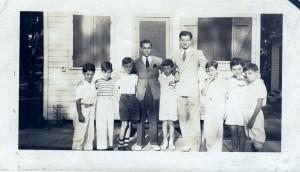
Camp Schonthal, Bunk 2, abt. 1940
l. to r.: Jonathan Horowitz, ?, ?, x Kaplan- counselor, Maynard Goldmeier, x Kaplan- counselor, ?, Marty Hoffman, Marv Greenberg
Courtesy of Dr. Maynard Goldmeier
Boys and girls went to the camp at different times. The calendar was divided into two parts – one month for boys and one for girls. Children could go for all four weeks or for as little as one week. Women went during the girls’ season and could come for various weeks as well.
It is important that Schonthal included both men and women in the community to finance the project. At age 73, he knew that in order to perpetuate the institutions he established and to grow the community with additional institutions, Columbus Jews needed to take up the mantle themselves and carry on his vision.
Ten cottages were erected, one of which was a first-aid cabin. The 16X23 feet cabin contained eight beds. Screened windows had permanent shutters as well. Wash rooms and showers were located close to the cottages. The administration building was both a mess hall and auditorium. “Modern equipment,” included a “Frigidaire,” dish washer, and boiler for hot water. On the second floor was the administrative staff’s living quarters and three extra sleeping rooms.
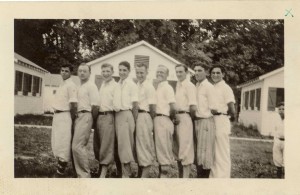
Camp Schonthal Counselors
1928- L to R: Brab, Beeker, Levinstein, Goldsmith, Cohen, Goodman, Levy, Schecter, Lakin.
The 35 x 60 foot swimming pool was seven feet in the deep end, so that both children and adults could use it. Leo Yassenoff and Mark Feinknopf, both members of the Schonthal Camp Committee, drove the entire construction of the project.
The “Chronicle” from the first meeting at Magnetic Springs, reported weekly on the progress of the camp and its editors “highly endorsed the program” . . . . “We feel,” they wrote, “that those who register will benefit physically, mentally and spiritually.” It reported that the food would be wholesome and kosher and that there would be one counselor for every seven campers.
When those who funded the camp, visited and inspected the facilities on June 10, 1927, the “Chronicle” reported on the spacious picnic grounds and baseball diamonds, the volleyball courts, as well as other splendid facilities “provided by the big hearted men and women, “ who, in cooperation with Schonthal” had made “this enterprise for health and happiness” possible.
The camp would be a Jewish camp. In addition to kosher food, the entire camp was centered on Jewish folklore and Jewish life. Religious services were held every Friday evening.” The Camp Council ceremonies were based on the “principles of Judaism.” It was hoped that children would be inspired to follow a religious and righteous life. For many of these children, whose parents had been secular Jews in Communist Russia, this would be their introduction to Judaism.
The camp, like the Schonthal Center, had an agenda. As stated in the 1928 Report of the Schonthal Camp for the Season, delivered by Mrs. Frank Basch, the “objects of Camp Schonthal were more than fulfilled – the promoting of health, harmonious living together, education in the general out-of-doors, a richer and deeper reverence for Judaism, last but not least, joy and happiness.
It was the purpose of both institutions to reinforce the Americanization of the children as well as to help them to become knowledgeable members of the Jewish community. At the same time, it offered to the campers first-rate instruction in a variety of sports for both boys and girls.
Joseph Schonthal died on December 19, 1929. His legacy continues to live in the Jewish Community Center which continues to build and adapt to the needs of the community. Perhaps his greatest gift was his insistence that there could be no division within the community, that rich and poor, each deserved the best institutions that their fellow Jewish leaders could build. His Schonthal Center was a shining jewel in the midst of a challenging environment for an immigrant population endeavoring to “make it” here in the “goldena medina.” The time that these men, women and children spent at the Schonthal Center was a respite from the reality of the challenges of everyday living.
By the late 1930s, Jews in Columbus who had immigrated after the turn of the century had climbed out of a marginal existence to take their place in a middle class society they helped create. When they became the community’s leaders, their Schonthal experience led them to create first-class institutions for the next generations. It is Schonthal’s incredible gift which enabled him to treat all folk as his equal that paved the way for a united Jewish community in the future.
IV –
The Jewish Center of Columbus
On December 25, 1945, the “Chronicle” announced in bold headlines that Samuel N. Summer would head a new Jewish Center building drive. The entire Jewish community and local organizations would be asked to support this building project to serve all elements in the city. At that time, it was not known where the Center would be located, when it would be built, nor what it would look like. What was known was that the Jewish community in Columbus was ready for a Jewish Community Center building. It had outgrown the SchonthalCenter which had been wonderful in its limited way for the job that it had been meant to do.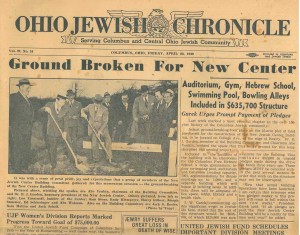
From the first announcement in December, 1945, until October 30, 1949, when the cornerstone was laid, the Building Drive was front page news in the “Chronicle” and the entire Jewish community had been mobilized even more so then in any previous community campaign for funds. Carrying Joseph Schonthal’s dream to its logical conclusion, the Jewish Center would be founded and funded by the Jewish citizens no matter what religious beliefs (Orthodox, Conservative or Reform) or status, no matter what role in their synagogues, clubs or businesses they had played. The Jewish Center would be “owned” equally by the Jews of Columbus. As Schonthal had dreamed it and as a headline proclaimed, the New Jewish Center would be the “hub” of the community.
Samuel Summer just happened to be Joseph Schonthal’s son-in-law. But this was not the reason he had been chosen to lead the campaign. Sam Summer was well-known in the community because he had led the campaign to build the Ohio State University Stadium., one of the first major fund-raising campaigns in Columbus. It was recognized at the time as one of the best planned and executed fund-raising projects in the country. Summer had long been respected in the community with a gravitas that had nothing to do with the fact that he was Schonthal’s son-in-law.
On January 11, 1946, a dinner meeting was held with community leadership to organize a major fundraising effort to raise at least $425,000 by the following summer. The idea of a Jewish community center building had been talked about as early as 1935 when the Federation put aside ten thousand dollars for its use. At the annual meetings of the Federation and Schonthal Center, the need for a Jewish community center was discussed. In 1938, the Federation asked the Jewish Welfare Board to conduct a feasibility study of the community. Its findings were conclusive that the community needed and wanted a new, larger building than the Schonthal Center for extended programming for the community. But world events intruded. World War II began as well as Hitler’s systematic annihilation of Europe’s Jews. Community attention and funds must be concerned with winning the war as well as assisting beleaguered Jews in Europe. All thoughts of a Jewish community center were set aside.
As soon as the war was over, the community asked the Jewish Welfare Board to conduct another study. The study, under the direction of Cincinnati Jewish Center Director Cyril L. Slesnick validated the conclusions of the 1938 study. The community as a whole very enthusiastically expressed their desire for a new modern Jewish center. In fact, there was no open opposition to it.
The youth in the community were among the most enthusiastic. It was concluded, in fact, that proper provision had never been made for youth and that the new Jewish Center should give the youth of the community major consideration.
The inclusion of an indoor gymnasium, swimming pool and bowling alleys was the direct result of this conclusion. In addition, a youth lounge and canteen would be provided as well. This new Jewish Center would, in fact, become the center of activity for Jewish youth in Columbus. It would further unite the community as teens from all over the city would participate together in activities and in the process form friendships and relationships which would continue throughout their lives.
With this report as validation for the need for a significant new Jewish institution in Columbus, leadership in the Jewish community was ready to raise the significant amount of money needed to accomplish this. With Summer as the chair an aggressive city-wide fund-raising drive was carefully staged. It would involve the entire community much as did the annual United Jewish Fund drives.
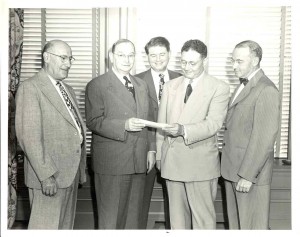
B’nai B’rith, 1949
Presenting check for new Jewish Center
l. to r.: Jacob Myers, J.W. Steinhauser, Herbert Wise, I.W. Garek, Robert Lazarus
The dinner at the Seneca Hotel secured commitments form community leaders for at least $100,000 in pledges. In addition, B’nai B’rith had made a gift of $15, 000 and planned to move its offices into the new building. With this as seed money, the committee felt comfortable in opening solicitation to the community. At that dinner meeting of over 150 community leaders, Selznick gave a report of his community study. From the findings of the survey, it was determined that the community needed a Jewish Center with an Auditorium, gymnasium, meeting rooms, banquet facilities and lounges suitable for receptions, dances and other social events.
The public campaign began. One hundred solicitors had canvassed some one thousand prospects and had pledges payable over three years. While collecting the money proved to be a challenge by February, 1949, $635,000 had been raised. While the money was being raised, Abe Yenkin and his site committee looked at various locations as well as visited other new Jewish Centers to determine the best plan for Columbus. It was decided that the new building would be constructed on College Avenue at the edge of Bexley. The Columbus Hebrew School who had been considering a new facility of their own would become a part of the building as would B’nai B’rith, the earliest organizational contributor. The building was planned to include bowling alleys, an indoor swimming pool, auditorium and gymnasium.
Samuel Summer died in March, 1949. Abe Yenkin succeeded him as Building Chair. Ground was broken the very next month and the cornerstone laying ceremony was held at the end of October. Jewish Center President I.W. Garek announced that the cornerstone laying ceremony would be a memorial to Joseph “Pop” Schonthal. The honor of actually placing the cornerstone was given to Joseph Summer, Samuel Summer’s son and Joseph Schonthal’s grandson. Summer remarked at the ceremony that the laying of the cornerstone was and would be the greatest thrill of his life.
The first Jewish Center edifice in Columbus, Ohio was magnificent to behold. Constructed by F&Y Building Service Inc, it reflected the talent of both Leo Yassenoff, the company’s president and its architect, Mark Feinknopf. Located on 25 acres of land, the building itself was 221 feet long and varied in width from 113 to 163 feet. With 50,000 square feet of floors and almost a million cubic feet of space, it housed three beautiful lounges, a complete game room, nine club rooms, an educational handicrafts room, an art room, photography room and a large social hall.
The gymnasium measured 82×60 feet with room for all indoor sports. A special exercise room had “slenderizing” equipment. Adjoining these rooms was a Health Club with massage and therapy room, wet and dry steam rooms and a locker room lounge. The tile-lined swimming pool was 20 x 60 feet and was completely enclosed in a room of its own. The auditorium seated 700 and had a theatrical stage properly equipped for professional productions.
The Center had both a Dairy and Meat kitchen and 12 polished hardwood bowling alleys used by young and old alike. This was just the start. Plans were in place for an outdoor pool to open the following summer. Handball courts, as well as volleyball, softball, baseball diamonds, a picnic area and playgrounds for the younger children were planned as well. The elegant simplicity of the brick façade of the building gave it a majesty and dignity worthy of the many hours of time and monies raised to construct such an impressive structure.
It is not insignificant that the first event at the new Jewish Center was held on May 5, 1950 and was the first United Jewish Fund mass rally to be held in Columbus. From that first HermineSchonthalCenter, it had been the purpose of Joseph Schonthal to unite the community in its participation in the activities in that building. This was a driving force in the new building as well.
The Jewish Center was built to be the center of Jewish activity in Columbus where Jews of all income levels and beliefs could work and play together and come to know one another, to work together for the common good. The United Jewish Fund was the fundraising arm of the Jewish Welfare Federation. It united the whole community in raising monies for institutions in Columbus, the United States and Israel. The Federation established the Jewish Center and even in Schonthal times, the two organizations held their annual meetings together. The New Jewish Center would take the place of the SchonthalCenter in continuing to bring Columbus Jews together.
The post war years, the economic upturn and the movement towards the suburbs brought Jewish adults and their baby boomer children to the new JCC. While programs at the Schonthal Center such as Naturalization Classes carried over, a new focus on children and Israel cultural identification began.
Mayer Rosenfeld, a Columbus native who had been at the Jewish Center in Kansas City, returned to Columbus to take on the role of Executive Director. He quickly added an assistant director and three additional directors: Meyer H. Schwartz became Assistant Director as well as Program Director. He was well known in Columbus for his work at Broad StreetTemple. The three other new directors were: Marvin Josolowitz, Director of Junior activities; Martin Livenstein, Director of Youth Activities; and Samuel Stellman director of Health and Physical Education. All three of these men were seasoned professionals and became favorites of the groups they led.
The first year in operation, showcased the Center’s commitment to all segments of the community. It became the permanent home of the Columbus Hebrew School and B’nai B’rith. The newly established Gallery Players moved to the Jewish Center to perform on their new stage. The Columbus Self Development School, a pre-school run by the legendary Rose Schwartz became a part of the JCC to expand their educational program.
This grand new building was envisioned as a central meeting place for all groups no matter what their religious, social or financial affiliations might be. With meeting space of all sizes and the ability to cater large events, this goal was quickly achieved. In March, 1951, the month of its formal dedication, the Center hosted meetings or events for the Jewish Welfare Federation, Hadassah, National Council of Jewish Women, Columbus Zionist District, Saturday Morning League Baseball, B’nai B’rith Women, and the Armed Services Committee. The “Delayed Pilgrims” event was planned. This was a program jointly sponsored by the Center, National Council of Jewish Women, Catholic Welfare League and the Church World Service Committee. Its purpose was to welcome New Americans. This event helped to set the precedent for interfaith and full community involvement at the Jewish Center.
One of the most significant community endeavors was the Blood Donor Drive. Established by the Jewish Community Council’s Blood Donor Council, the first Donor Day was in 1951. Held at the Jewish Center it was a highly publicized event. In the second year of the drive, it was reported that the American Red Cross Bloodmobile would be stationed at the Jewish Center from 2 until 8 PM on October 5. As was reported, everything possible would be done to make it easy for everyone to participate. A motor pool would be available to transport donors to and from the site. An all-day nursery would be provided so that young mothers could participate. This was one of many programs in which the Jewish Center participated with the general community through the years.
The sports teams and leagues that were used to traveling to other locations so that they wouldn’t have to practice in the small Schonthal gym suddenly found themselves with a home advantage in their magnificent new basketball court. And the most popular asset in this new Jewish Center was certainly the state of the art bowling alleys which were enjoyed by both adults and youth and became a sort of a meeting place for teen agers from across the city.
All of these additions served as a catalyst for young people from every income group and religious belief to meet together, to form lasting friendships, to insure that this next generation of Jewish Columbus would be even more cohesive than their predecessors. That the Jewish Center purposely pulled youth from across the Columbus area is illustrated in the Teen Age Council, TAC.
The Teen Age Council was made up of all of teen groups in the community. The presidents of each group met together once a month to plan a variety of events for all teens in the community. The clubs involved in the early 50’s were: AZA; sororities, STP and Phi Gamma Gamma; KTZ, a fraternity; Councilettes, the teen division of the Council of Jewish Women; YFTL, the Temple Israel Youth Group; and B’nai B’rith Girls.
These groups sponsored such events as a Purim Festival, an Oneg Shabbat, a Brotherhood Program , and Stunt Night. Stunt Night, an annual affair, was a competition between organizations which put on original skits. It was highly competitive and prepared for months. Each of the clubs took turns sponsoring Teen Canteens twice a month in the Center game room.
For the teen-age boy, the Jewish Center offered many opportunities to participate in sports such as basketball, softball, wrestling, handball, and swimming.
At the other end of the spectrum, one of the most exciting new ventures was the establishment of the Golden Age Club in March, 1951, in cooperation with the National Council of Jewish Women. With Dottie Rosenfeld as its first chair, it started with 8 charter members and grew to 150 members in the next few years. This club was organized to “provide quality services and activities for seniors in the community.”
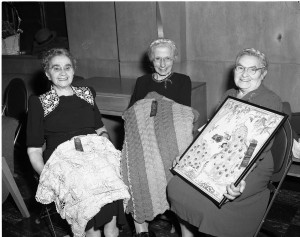
Golden Age Club 1951
Winners of the hobby show. L. to R.: Mrs. Erlen for crocheted tablecloth, Mrs. Ringer for knitted afghan, Mrs. Pler in the embroidery group for a peacock picture. Photo by Herb Topy.
One of the most unique events early on was the Golden Age Club Rally, an annual interfaith event which was held at the Jewish Center in 1955, the second year of its existence. In 1963, a Midwest Golden Age Conference was sponsored by the Columbus Jewish Center.
Art classes, entertainment, games, picnics at Blacklick Park, outings, and holiday celebrations with both day and evening programming continued until the 1990’s. Senior programming expanded and changed to meet the needs and desires of this age group;. In 1975, New Horizons, sponsored by the Jewish Center and Geriatric Outreach Services targeted retired and semi-retired persons from ages 55-65 who were not Jewish Center members for social, educational, recreational and community service programming. It eventually expanded its mission to include senior adults about age 60.
An important service was offered in 1976 when the Jewish Center partnered with Heritage House and the Geriatric Services organization to offer a congregate meal program (NICE). With federal and state funding, this program provided one kosher meal per week for seniors. The program grew to offer activities and other opportunities to socialize.
The new Jewish Center had facilities which lent themselves to cultural and visual arts. The arts have played a major role throughout the history of the Jewish Center. From music, theater, film and dance to sculpture and painting to literary endeavors, the arts have flourished.
From the first, the visual arts have been given prominence in the Jewish Center agenda. In 1951, the Jewish Center dedication was accompanied by an art show which featured both local and national artists, in the lobby of the new building. In 1965, the Center was honored to have the Columbus Art League’s Every Member Show held at the building. This show drew attention from all of Columbus and surrounding areas.
The visual arts have been represented through classes in a range of mediums, frequently taught by well-known local artists. Classes were held for all ages from the youngest to the most senior. Specialized art rooms were included in the 1950 building even housing a kiln for the sculpture class.
Music has added to the tapestry of events at the Jewish Center. Dance, from ballroom to ballet, tap to modern, folk to interpretive movement has been offered from the early 1950’s.
The Jewish Center Community Orchestra formed originally in 1952, presented several concerts during their season. Consisting of both amateur and professional musicians, the orchestra was active for over 30 years. A Jewish Center Community Choral and a Jewish Center School of Music began in the 1950’s.
Theater has played the most prominent and enduring role of all of the arts. In 1950, Gallery Players, a group dedicated to presenting theater with Jewish themes by Jewish playwrights, accepted the invitation to become the Jewish Center’s resident theater group. The company was the first theater group in Central Ohio to implement a casting policy that did not discriminate on the bases of race, religion or gender.
Through the years, Gallery Players has provided theater for adults, children and young adults. In 1951, a teen age and young adult dramatics group began at the Jewish Center and presented its first play soon thereafter. Gallery Teens was organized in 1957.
This led to the Gallery Youth Theater in the 1970s. Gallery Tweens was formed the Center’s Tweenage Drama Group in 1961. A Children’s Theater Department, established in 1986, taught children the backstage work of theater productions and allowed them to participate in stage performances.
The International Film Series began at the Center in 1959 as a part of Adult Activities. The Jewish Film Festival began in 2004. The first of many very successful Jewish Book Fairs was held at the Center in 1963. With the full participation and cooperation of Jews throughout the city, various agencies and institutions including synagogues and organizations sponsored speakers.
Not only were programs and classes in the arts offered, but Adult Education Classes as well as Lecture Series offered a wide variety of Jewish topics. In 1951, the first Adult Institute of Jewish Studies was established at the Jewish Center. It was a joint effort of the ColumbusHebrewSchool, The Jewish Center and the various synagogues in the community. In that same year, the Jewish Center Cultural Series began. Its first speaker was one of the most eminent Jewish historians at that time, Dr. Salo Baron whose topic “Jewish Survival – A Historic Challenge” – drew a very large audience to this event which was free of charge.
Perhaps the activity most highly participated in at the New Jewish Center was adult sports. The state of the art bowling alleys were the star attraction. Dedicated in September, 1950, the alleys were immediately home to the Jewish Center Bowling Leagues. Three major entities formed the first leagues. They were the “All Star Jewish League” also known as the “money bowlers,” because their weekly fees were put into a cash fund for prizes instead of parties and trophies, included eight teams: the Browns, Tigers, Dragons, Panthers, Bombers, Cardinals and Broncos. The Jewish War Veterans Capitol Post 122 sponsored twelve teams in its league, and B’nai B’rith Women fielded 16 teams.
Grand Opening Ceremonies for the Center Bowling Lanes were recorded in the Chronicle with Center President Garek cutting the ribbon and tossing the first ball. The lanes were open to the public before and after league times. The bowling alley became one of the most popular places in the new Jewish Center for teens to congregate, especially on Sunday afternoons.
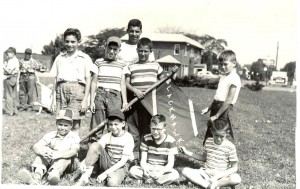
Blackhawk Campers, c.1953
Campers in front of the Jewish Center. Front l. to r.: Norm Sher , Colman Kahn, Michael Kravitz, Frank Kass Rear: R L Stine, Ira Sutton, Phil Levine, Preston Gurwin.
Courtesy of Preston Gurwin
The New Jewish Center outdoor swimming pool opened in July of 1951 and the baseball diamond in July of 1953. Hundreds of children used these facilities. Little League baseball was brought to the Center in February of 1952.
The first Jewish Center handball club was initiated in 1951. Badminton, Major League, Minor League and Little League Baseball were started in 1952. And an “Old Timers” Softball League was established by sports reporter Lou Berliner in 1952, as well. In July, 1953, the baseball diamond was lighted, fulfilling the dream of sports enthusiasts Alex Clowson and Don Shusterman.
The first Sports Award Banquet was held in April of 1953 with Woody Hayes as speaker. In 1961, a Banquet of Champions was held, celebrating 10 years of Jewish Center sports awards. Three hundred people attended this event which was held at the Jewish Center site.
In 1979, the first Jewish Center Sports Hall of Fame was presented. The first four inductees included Lou Berliner, Alex Clowson, Leah and Thelma Thall.
Fresh air camping had been an important item on the Jewish Center agenda since Schonthal Center days. The new Jewish Center offered Camp COJACEE, a day camp for boys and girls ages 5 through 11. Using the Jewish Center building as its headquarters, the camp operated five days a week from 9:30 AM to 4:30 PM. Hot Kosher lunches were provided under the supervision of an experienced dietician.

Jewish Center Sailing Club, 1953
Heading to Buckeye Lake, l. to r.: Sonia Stevens, Honey Fisher, Char Stevens, Rita Stevens
Courtesy of Honey Abramson
The program included swimming, dramatis, arts and crafts, sports of all kinds, special parties and trips to local points of interest, as well as overnight camping. In the development of the program, many phases of Jewish life and culture were presented in a meaningful way.
In 1955, Cojacee became an outdoor camp for the first time. Tents would be used on the grounds which had been landscaped to accommodate this activity. In 1958, Rose Schwartz, pre-school director, organized a new camp for children ages 4-6. The half day program would be called Camp O’ra. Cojacee would then include grades 2 through 6.
In 1960, a Tween co-ed camp was established. It included grades 6-8 with a large schedule of activities including tennis, golf, horseback riding, canoeing, archery, drama, and other outdoor camping activities. In 1963, A Fitness Camp was started. Using both the natural outdoors and indoor equipment such as the trampoline, the high bars and tumbling mats, this coed camp was led by Stu Greenberg.
In 1964, Camp Pioneer for 5th and 6th graders was started on newly acquired land west of Alum Creek. In 1965, Millard Cummins donated land to the Jewish Center on Hoover Dam. Called Cubbage Corners, it was located in Westerville, 30 minutes from the Jewish Center. This picturesque setting was perfect for a day camp which could give campers a “sleep-away camp feeling,” while still sleeping at home in their own beds.
Anything from swimming, sailing, and canoeing to sports including archery, arts and crafts, soccer and football, was offered every morning when each camper could choose two individual activity sessions among some thirty-five activities offered. In the afternoon, campers came together in “bunks” for an hour of activities as varied as swimming, boating, arts and crafts and Judaics. Pioneer Day Camp moved to this site in 1965.
In 1969, an outdoor pool was constructed at the Hoover site. At that time, the first performing Arts camp for Teens, Gan Ma Tov, opened at the Hoover Site. In 1979, the Berman family established an endowment to build a retreat which would serve as a family recreation center and day came at the Hoover site.
In addition to the many activities offered by the Jewish center for all ages in the arts, education, and sports, the Jewish Center has been the site of major significance to the Jewish community, both locally and internationally. Politics, social issues, and minority rights, as well as celebrations of culture and heritage have been showcased here.
The first event ever held at the Jewish Center was the May, 1950 United Jewish Fund rally. This first city-wide UJF rally brought the varied Jewish organizations, dignitaries including the governor, a nationally known Jewish journalist and educator, the director of the local NAACP, local celebrities, and the general public to the grounds of the new building.
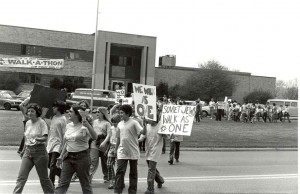
“We Walk As One”, 1977
Junior Division of Columbus Jewish Federation
Jewish teen groups walk to raise funds for UJF campaign
The Jewish Center has been the rally site for many causes over the years. In 1955, a silent walk with 175 representatives of the various Jewish youth organizations was held to support the Jewish youth of the Soviet Union. In the 1970s, many groups met at the Jewish Center to rally for the rights of Soviet Jews. In 1976, a Walk-A-Thon for Israel brought the community together and in 1977 “We Are One” was the theme for a UJF walk which included members of all of the Jewish youth organizations.
Celebrations of Israel’s Independence Day have been held annually at the Center. Israeli cultural guest artists and various speakers are frequent visitors. Local, state and national politics also bring the community to the Jewish Center. Candidates nights have been held regularly throughout the years as have political discussion groups. The Jewish Center has also welcomed the community as the neighborhood voting location.
We can see that after three decades, the “new” Jewish Center had expanded its holdings off site in at least two locations. Its activities both at the main campus and its satellites had expanded as well. Actually, leadership had looked at the facilities after only two decades of use. The results of this analysis would lead to the most ambitions building campaign ever attempted in Columbus. Ohio.
V –
The Leo Yassenoff Jewish Center – 1975 to Present
As early as 1967, Jewish leadership realized that as magnificent and useful as that first Jewish Center building had been, it needed a make-over. The Center Board began to consider refurbishing the building. But once again, world events interrupted a community’s plans. The Six-Day War followed in the early 70’s by the Yom Kippur War necessitated that community funds be focused on Israel. Consideration of any changes must be put on the back burner until Israel was out of danger.
In 1975, the so-called Rotman Study, conducted with the help of the Jewish Welfare Board, concluded that rather than extensive remodeling a new building was what was needed. The Godwin – Bohm NBBJ architectural firm was hired to draw up the plans. The first gift to the new building was a $500,000 grant from the Battelle Memorial Institute.
The question of location for the building became a source of serious contention. A significant group of Center members living in Bexley, Berwick and Eastmoor wanted it to remain where it was. A citizens’ groups which called itself FOCAL, (For Our College Avenue Location), was formed.
While the College Avenue site was the prime location, three other locations were originally considered. A subcommittee working under the joint Jewish Center–Jewish Federation Committee on the new Jewish Center felt that it was its responsibility to be sure that the College Avenue site was, indeed, the best space for a proposed six million dollar edifice. The three other sites were located in Columbus between East Main Street and East Broad Street. One location was inside the 270 Outerbelt, the other two outside of it.
Obviously FOCAL felt that the Center should stay where it was and wanted to make sure that it had a say in the process. It became a very effective citizens’ lobbying group. It had only a short time to conduct its campaign. Dr. James Tenenbaum, President of the Jewish Center and Barton Schacter, its Executive Director wanted the decision to be made in two months. FOCAL called its first public meeting for August 17.
The agenda for that meeting, as reported in the “Chronicle.” included an analysis of its reasons for keeping the Center at the present site, handing out petitions and lists of persons to contact, and giving interested citizens a chance to express their personal reasons for wanting the Center to remain where it was . These public testimonials would be recorded and transcribed for presentation to Board members in an attempt to convince them of the sincerity and urgency of the requests to drop consideration of all alternative sites.
By mid-September, only two sites were to be considered and were presented at an open meeting on Sept.18. The original site was, of course, the College Avenue location and the second site would be somewhere on McNaughten Road between Main and Broad Streets, a great distance from the present site, It was at the Outerbelt on the far East Side.
Needless to say FOCAL was not pleased and continued its campaign of petitions. In addition, it urged all Center members and interested citizens of the communities near the present Center to make their feelings known to the Board of Directors of the Center.
The open meeting drew an attendance of 600 people. It was learned there that petitions from one third of the Center membership were presented to the officers of the Center by members of FOCAL. The meeting was highly charged emotionally and most of the people there felt that the new Center should remain at the College Avenue site. Eventually both sides came together to support the decision, and move forward as a unified community. Mel Schottenstein, who was Trustee Chair of the Yassenoff Foundation, had advocated for the McNaughton Road site. After the vote, he stepped forward to become the driving force in the campaign for building on the College Avenue campus.
On September 28, the “Chronicle” reported that the Board of Trustees had voted to build the new Center on the College Avenue site. The new 90,000 square feet building would be twice the size of the present Center. It would be two stories and would be built on the “zone” concept: each department would have its own wing. The parking lot would be built to hold 300 plus cars. A camping area would be able to service 200 youngsters.
This Jewish Center plans were drawn to meet the needs of the handicapped, elderly and children. It would furnish recreational space for a “growing women’s and men’s leisure time and health oriented society.” A large gym and indoor running track as well as ten indoor racquetball courts as well as fully equipped health club facilities would make the Jewish Center one of the premier athletic clubs in Columbus.
In June of 1979, drawings and concepts of the new center were presented at the annual meeting. Included in the plans were a 325 fixed-seat sloped theater, a spacious all purpose room for banquets and meetings, and a kosher restaurant.
Long time community leader, David Roth was appointed Chair of the Building Committee. In speaking of his appointment, Center President William Goldman said that building a NewCenter “is essential if we are to continue the perpetuation of a Jewish way of life as we know it in our community.”
In 1950, the Jewish Center agenda was described : “It helps build and mold the character of youth and teaches them by action and example, the democratic process of life. It concerns itself with the less privileged . . . makes its facilities and programs available to them . . . and helps to build upright citizens.”
As Rabbi Marc Lee Raphael noted in his history of the Columbus Jewish community, Jews and Judaism in a Midwestern Community: Columbus, Ohio, 1840-1975, “Although new Jewish centers around the country increased Jewish identity during this period, the publicity releases about the Center’s dedication expressed the hope that the Center would serve the entire Columbus community.” Fred Lazarus, Jr., wrote the Jewish Center Dedication keynote speech. It was delivered by his son, Charles, when Fred was unable to attend the ceremony:
“It will show the Jewish and non-Jewish youngsters that they are not necessarily unlike. In the use of this Center you will find added incentive to participate in the American way of life.” Acculturation was a driving force on the agenda of this first Jewish Center building in Columbus.
By the 1980s, Jews in Columbus and the United States, had become acculturated to such an extent that the fear of assimilation became the driving force, thus the emphasis on “a Jewish way of life.” It is this sentiment that informed the rhetoric used to encourage Jews in Columbus to contribute to the new building.
At the Annual Meeting on June 13, newly elected President William Goldman stated again the purpose of the Jewish Center when he said that commitment to building a new Center would rekindle “Jewish culture, programming and an awareness and spirit of Judaism that will flow through our children and theirs. We have the resources,” he said, “to influence future generations by the development of not just the structure of a new Jewish Center, but of the content of the program in the new Jewish Center, which will certainly affect the continuity of Jewish family life.”
Fund-raising for the new Center was high tech. In the campaign for the 1950 Jewish Center, one hundred solicitors contacted over one thousand potential contributors. One thousand contributed. At that time there were approximately 7000 Jews in the Central Ohio area. By 1980, thirty years later, the community had grown and technology had blossomed. Access to all sorts of media gave this campaign opportunities that had not existed before.
One of the most effective ways of spreading the Jewish Center story was a multi-media presentation. Every community group and organization in the community would have access to a special multi-media presentation which would explain the Jewish Center, its philosophy and activities and the need for a new structure. Groups would schedule the production for showing after Nov.1, 1979.
In addition, the Center would also provide qualified speakers, knowledgeable about the new Center and the new building project to lead question/answer sessions following the viewing of the multi-media presentation.
The “Chronicle” announced that hundreds of volunteers would be needed in the Spring of 1980 in all areas of the campaign, including telephoning and speaking to groups as well as personal visitations to individuals. These people would help interpret, explain and educate the community on the new Jewish Center Building.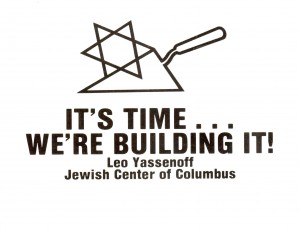
A new slogan for the campaign was announced: “It’s Time . . . Let’s Build It!” with a graphic of a Mogen David astride a spade. On June 5, it was announced that two major gifts, one from the Leo Yassenoff Foundation and the other from the Battelle Memorial Institute had been received by the Capital Campaign. The contribution from Battelle of $500,000 had been announced in 1977 as the first major gift to the campaign. The Yassenoff Foundation’s gift of $300,000 was received early in 1980.
In July, 1980, it was announced that a “Once in a Generation Gala,” celebrating the Center’s sixty-seven years of service to the community, would take place on July 27 at the Sheraton Hotel. An invitation to this black-tie affair was based on a three thousand dollar contribution to the Capital Campaign payable over three years.
A special tribute would be given to David Roth and Mel Schottenstein, Roth for the outstanding role he had played as chair of the Capital Campaign and Schottenstein for the significant role he had played in motivating the greater Columbus community to support the drive. In the meantime, parlor meetings and personal solicitations were continuing.
The GALA was a great success. Over four hundred people made the three thousand dollar minimum contribution to the Campaign and attended the black tine event. Almost five million dollars had been raised in the GALA and by solicitation.
Due to the success of the Gala, it was decided to have “ENCORE!” another major fund raising event on October 12. A minimum gift of one thousand dollars payable over three years was required to attend. An encore showing of the 13-projector multi-media production originally shown at the GALA would be presented. This extravaganza, recreated through sight and sound memorable moments of Jewish Center history.
In addition, a photo maze, a 67 year review of the Center would be on display. Over three hundred people attended the reception and candle light supper at the Columbus Sheraton. Both events were catalysts through which $5.5 million dollars were raised.
It was anticipated that ten million dollars could be raised in this Campaign, the largest amount raised for capital purposes by Columbus, in fact, by any private group in central Ohio. By the spring of 1981, $7.3 million dollars had been raised, due in part to a $700,000 challenge grant by the Leo Yassenoff Foundation. This was enough money to break ground. The new Jewish Center would be called the Leo Yassenoff Jewish Center in honor of the generosity of Leo Yassenoff during his life and of the continued generosity of the Foundation after his death.

Groundbreaking Day, 1981
l. to r.: B. Lee Skilken, Bernard Yenkin, Charles Schiffman, Barton Schacter, Dennis Mellman, Michael Talis
The Groundbreaking for the new Jewish Center was held on May 15, 1981. Over 400 adults and children were present. Co-chairpersons of the event, Bea Roth and Dr. James Tenenbaum welcomed everyone and expressed their joy and excitement that were felt at having reached this milestone in the history of the Columbus Jewish community.
Representatives of all areas of Center life turned the first shovels of dirt. Participants were Edwin Ellmann, William Goldman, David Roth, Barton Schachter, Irving and Mel Schottenstein, Michael Talis, and Dr. James Tenenbaum. A special event was the performance of Jewish Center pre-schoolers wearing hard hats. They sang “Hand in Hand”, the award winning song written for the GALA and ENCORE! events.
In the keynote address by Center President William Goldman, he thanked the 700 individuals, families, foundations and businesses that contributed the $7.3 million dollars that enabled the Jewish Center to begin construction. They had almost reached their goal of $8.4 million dollars. The financial commitment of every member of the Jewish community was needed to achieve this goal.
To this end, an extended phon-a-thon was held from June 21 to June 28. Co-Chair person Nancy Paul said that it was the goal of the phon-a-thons to “obtain the financial commitment of every Center member who had not yet made a contribution to the NewBuilding campaign. In this way,” she said, “we can ensure the successful completion of the fundraising drive and build our beautiful New Jewish Center for which we have waited so long.”
Campaign activities during the construction period focused on individual solicitations and several major foundation gifts by the Kresge Foundation, Ohio Commission on Aging and the Kaplan-Halpert Foundation. Special events such as an art action, the Corporate Fundraising Reception and the Sports Spectacular held on August 16, 1982 at Winding Hollow Country Club gained impressive results.
The Community Celebration for the opening of the Leo Yassenoff Jewish Center was held on Sunday, January 16, 1983. It was not the usual celebration with speeches and ribbon cuttings. Rather it focused on two activities which this new Jewish Center would emphasize, sports and the visual arts. The day began with the Annual Sports Hall of Fame brunch at 10:15 AM in the new multi-purpose room at the Center. Then, the formal opening ceremonies would be held at 1:00 PM. This was followed with an exhibit of and reception for the very talented Sid Chafetz’ art work. The reception would be held from 2 to 4 PM. Immediately following this, the Sports Hall of Fame presentation of the four men honored that year was held. These men were: Ray Benjamin, Jerome Fisher, Sam Gordon and Ben Sully.
The emphasis on sports was continued in 1984 when the first Senior Olympics were held on Labor Day Weekend, September 2nd and 3rd. The oldest participant, 84 year old Eva Bernstein, participated in the 50 metre and 100 metre free style swim event. Participants came from Cleveland, Louisville, and Cincinnati. The games were run by age divisions with each division receiving gold, silver and bronze medals.
This event was open to all senior citizens regardless of religion or race. It was sponsored by the Columbus Citizen/Journal, Hameroff/Milenthal Agency and the Jewish Center.
In 1984, the tryouts for the Maccabi Games were held at the Jewish Center. In 1985, the Jewish Center hosted the Midwest Youth Maccabi Games which were seen as training for the 1986 International games in Toronto. Young athletes ages 12 to 25 participated in soccer, tennis, racketball, basketball, track and swimming. These games were a community event. Families hosted kids from the many Midwestern cities and towns which participate.
In 1989, the Jewish Center held three sports camps involving some 120 campers. For one week, campers participated in tennis, soccer, softball, basketball, and water sports, synchronized competitive swimming, diving, and snorkeling.
The 1980’s and 90’s found the Jewish community in Columbus reaping the rewards of a strong economy. After school sports were stressed. Participation in these sports required a commitment to hard work and devoted parents who car pooled their children to the wide variety of activities offered.
Competition was keen. From an early age, sports were central to their childrens’ experience. The Jewish Center’s camps reinforced this community commitment to children’s sports.
One of the most exciting events in the new building was the so-called “Celebration of Life.” Held for three days in November, 1987, this festival was to show the many accomplishments made by community members in many aspects of their lives. Its purpose was to promote a fuller life for adults. While they were not identified as senior adults, clearly it was this segment of the population upon whom these activities were focused. Seniors from the Cleveland and Dayton Jewish Centers and other cities participated, as well.
Workshops, entertainment, displays of crafts and hobbies were accompanied with a talent show. The grand finale was a dance with songs from the decades from the 1930s to the 1960s. From a DJ to a dessert table it was a real event. This event reinforced the concept of empowerment of senior adults to lead as active and productive lives as they had when they were middle age.
Adult Jewish learning was an important agenda item as well. The Community College of Adult Jewish Studies opened in fall of 1984. Faculty were community rabbis, MeltonCenter faculty and community educators. The kickoff event for the school was held on October 29.
Irving Howe, one of the most preeminent American Jewish scholars, was the speaker. His book, World of Our Fathers, the Journey of the East European Jews to America and the Life They Found and Made had been published several years before the event and met with great acclaim. It is the most comprehensive account of the East European Jews’ acculturation in this country. It is an especially moving account of those who survived the terrible challenges of the Lower East Side. Howe had become a bit of a celebrity due to this publication.
This community college can be seen as a forerunner to the Florence Melton Mini-School which opened in the fall of 1988. Although Mrs. Melton was one of Columbus’ most outstanding lay leaders, her school was and still is international. It is a two year course in which students meet two hours every week for thirty weeks to learn all aspects of Jewish living, history and custom. The Jewish Center hosted this very effective school which took the place of its own programs in adult Jewish learning.
At least two endowed lecture series have been created at the Jewish Center, the Gordon Cultural Arts Series and the Gaynor Lecture Series. In addition, the “Gateways” program for outreach to intermarried couples, chaired by Miriam Yenkin proved to be most successful. Another important project was the Jewish Teacher’s Resource Center which provided materials to teachers in the Sunday Schools and Day Schools.
The 80s and 90s, the ending years of the Millennium found an ever changing and adapting Jewish Center. By the end of the 1980s, the need for Jewish early childhood services had extended well beyond the east side of the city so the Jewish Center established a northwest branch of the pre-school and day care in a small house on Bethel Road in 1987.
In 2006, the JCC opened its second new location in New Albany. By 2004, the JCC New Albany had joined with the Columbus Jewish Day School in a New Albany school building. Then, in 2009, these two institutions moved together into a new building on Granville Avenue.
The main JCC building also continued to grow and change as populations and interests shifted. A greater need for early childhood services was reflected in the groundbreaking for the Ellman Early Childhood Wing in 2001. It opened in 2002. Reflecting the growing emphasis on personal health and fitness, the Diamond Family Fitness Center opened in 2002 providing 4,500 s.f. of state of the art fitness space.
On the main campus, the outdoor areas were enhanced in 2007 by the opening of the William Barkan Memorial Sports Court and the Baker Family Sprayground. The Zusman Center, a shelter house for camp and after school programs, opened the same year.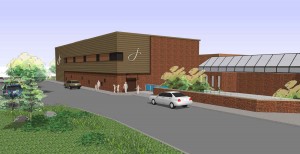
In December 2012, ground was a broken for a new addition to the College Avenue site. This will add 16,000 s.f. of space including the J-Zone for youth fitness and more meeting space.
On May 1, 2013, an exhibit, “JCC 100: The Center of It All” opened in the main building. Prepared by the Columbus Jewish Historical Society, it was a retrospective recording in photos and words of this institution’s history. If the past is prologue to the future, the Jewish Community Center in Columbus, Ohio, will grow and change but in the next 100 years, it will continue to be the CENTER of it all.
